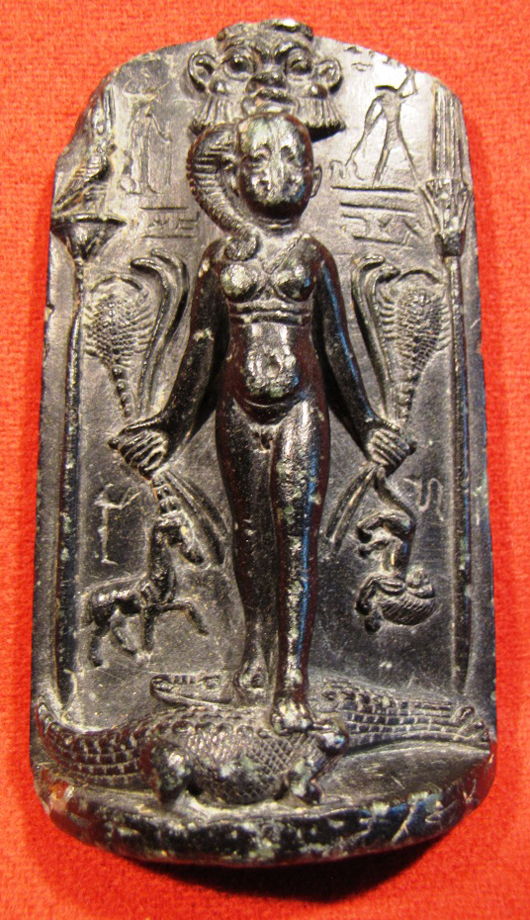
MILAN, Italy – It was probably during a trip through southern Italy in the 4th century BC that the small late Egyptian stone known as “Horus on the Crocodiles” went missing. It was, by all appearances, a talisman against snakes, crocodiles, and scorpions owned by a traveler. Many centuries later, at the end of the 1970s, the object was recovered during a dig in the city of Crotone, in the region of Calabria, by a worker who recognized the rarity of the stone and decided to keep it.
The worker was so proud of it that he always carried it in a small bag hanging around his neck and used every opportunity to show it off, until someone stole it from him.
It was not until 35 years ago that journalistic research drew public attention to the stone. The regional detachment of the Carabinieri Department for the Protection of Cultural Heritage started an investigation that led to their locating the object in the Sforza Castle Collection in Milan. In February 2012 the stone was returned to the Archeological Museum of Crotone.
This is just one of several stories of recoveries achieved between 2001 and 2011 by the Calabrian Unit of the Carabinieri Department for the Protection of Cultural Heritage, based in the city of Cosenza. Thirteen of these stories are now the subject of an exhibition titled “Recoveries 2001-2011,” running at the National Gallery of Cosenza through May 6.
The exhibition aims not only to celebrate 10 years of activity of the regional unit of the Carabinieri, but also to call attention to the problem of illegal traffic of antiquities, which is aided by the general lack of transparency of the art market. The anonymity of art transactions, for instance, makes the illegal market of antiquities easier; some art dealers prefer to turn a blind eye to an object’s provenance in order to close the deal and because they do not want to lose their suppliers.
In the case of antiquities, it is even more complicated because they are often stolen directly from the archaeological sites and there is no record of them at all. However, the Italian security forces are very well organized in the fight against art crime. The Carabinieri units for the Protection of Cultural Heritage, established in 1969, are active throughout Italy and collaborate with international security forces abroad, with whom they have a very good reputation.
Besides the stone of Crotone, the exhibition includes the so-called Askos, a 5th century BC bronze oil jar in the shape of a siren, which was returned to Italy by the J. Paul Getty Museum in Los Angeles. Its story is even more incredible than that of the Horus stone. After laying underground for 2,500 years, the Askos was found by some graverobbers who sold it to an intermediary for ten million lire (around $6,000), plus a cow. A collector later sold it to a Swiss art dealer for $400,000 who, in turn, sold it to the Getty Museum for $600,000. A long negotiation between the Getty Museum and the Italian government followed before the object came back to the place where it had been found.
This is not the only item coming from an American museum. There is a Greek amphora, as well, that Shelby White, a famous antiquities collector and a trustee at the Metropolitan Museum of Art in New York, had donated to the Museum of Fine Arts in Boston. The amphora was returned to Italy in 2006 together with other archeological treasures.
The exhibition in Cosenza includes paintings, as well. Among them are three oil-on-canvas artworks painted by Neapolitan artists from the 17th and 18th centuries—namely “Still Life With Peacock and Turkey” by Paolo Porpora, “Flight into Egypt” by Francesco “Pacecco” de Rosa and “Minerva and Venus” by Paolo de Matteis—all of which were stolen from the house of Baron Sanseverino. The thieves entered the house during a night when nobody was in and stole the most part of the baron’s art collection. They tried to peddle the paintings through the Florence art market, but they were caught by the security forces.
Another painting, “Madonna of the Rest” by Giuseppe Pascaletti, was recovered in the studio of a restorer who had kept it for more then 10 years. When it comes to illegal art traffic it seems no one is beyond suspicsion. The 19th-century silver “Pelican Ciborium” was sold by the priest of the church where it was preserved. He stated he had done it for charity.
# # #
About Silvia Anna Barrilà:

Silvia Anna Barrilà is an Italian fine arts journalist and regular contributor to the Italian financial newspaper Il Sole 24 ORE (ArtEconomy24). She also writes about art, design, lifestyle and society for a number of Italian and international magazines, including DAMn Magazine and ICON (Mondadori). She is based in Milan and Berlin.
ADDITIONAL IMAGE OF NOTE



